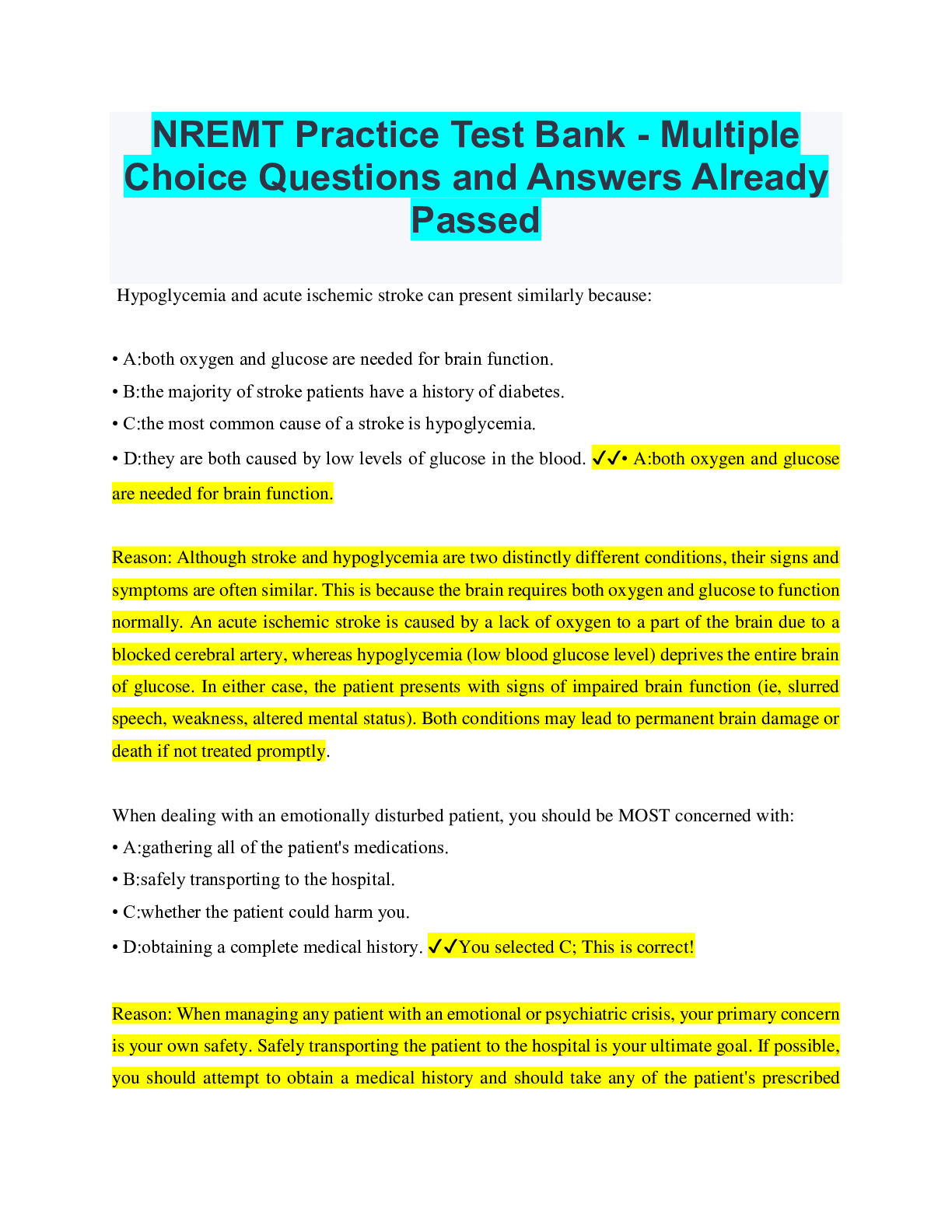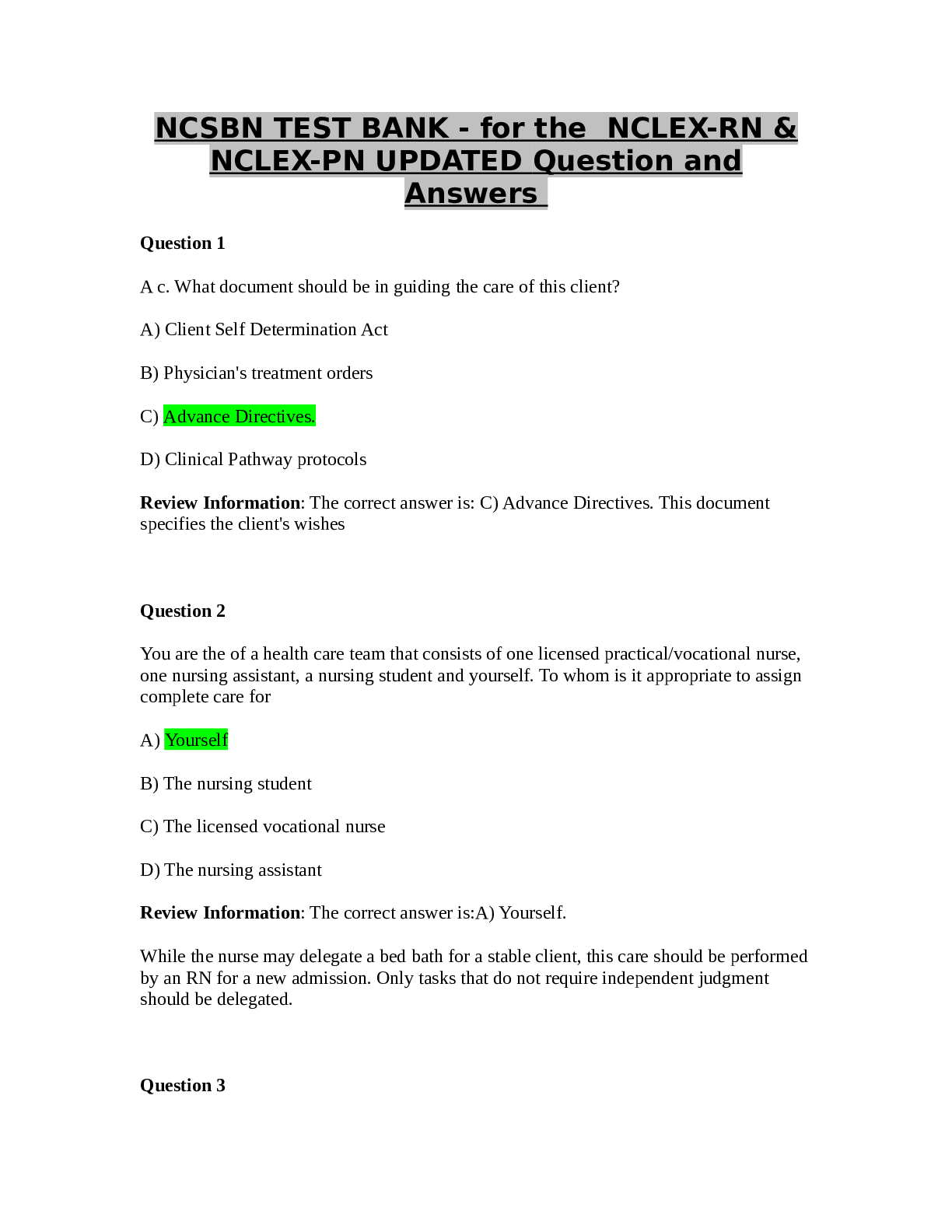EMT-B - Emergency Medical Technician - Basic > TEST BANK > NREMT Practice Test Bank - Multiple Choice Questions and Answers Already Passed (All)
NREMT Practice Test Bank - Multiple Choice Questions and Answers Already Passed
Document Content and Description Below
Hypoglycemia and acute ischemic stroke can present similarly because: • A:both oxygen and glucose are needed for brain function. • B:the majority of stroke patients have a history of diabetes. ... • C:the most common cause of a stroke is hypoglycemia. • D:they are both caused by low levels of glucose in the blood. ✔✔• A:both oxygen and glucose are needed for brain function. Reason: Although stroke and hypoglycemia are two distinctly different conditions, their signs and symptoms are often similar. This is because the brain requires both oxygen and glucose to function normally. An acute ischemic stroke is caused by a lack of oxygen to a part of the brain due to a blocked cerebral artery, whereas hypoglycemia (low blood glucose level) deprives the entire brain of glucose. In either case, the patient presents with signs of impaired brain function (ie, slurred speech, weakness, altered mental status). Both conditions may lead to permanent brain damage or death if not treated promptly. When dealing with an emotionally disturbed patient, you should be MOST concerned with: • A:gathering all of the patient's medications. • B:safely transporting to the hospital. • C:whether the patient could harm you. • D:obtaining a complete medical history. ✔✔You selected C; This is correct! Reason: When managing any patient with an emotional or psychiatric crisis, your primary concern is your own safety. Safely transporting the patient to the hospital is your ultimate goal. If possible, you should attempt to obtain a medical history and should take any of the patient's prescribedmedications to the hospital. However, this should not supercede your own safety or interfere with safely transporting the patient. You are at the scene where a man panicked while swimming in a small lake. Your initial attempt to rescue him should include: • A:rowing a small raft to the victim. • B:reaching for the victim with a long stick. • C:throwing a rope to the victim. • D:swimming to the victim to rescue him. ✔✔You selected B; This is correct! Reason: General rules to follow when attempting to rescue a patient from the water include "reach, throw, row, and then go." In this case, you should attempt to reach the victim by having him grab hold of a large stick or similar object. If this is unsuccessful, throw the victim a rope or flotation device (if available). If these are not available, row to the patient in a small raft (if available). Going into the water to retrieve the victim is a last resort. The rescuer must be a strong swimmer because patients who are in danger of drowning are in a state of blind panic and will make every attempt to keep themselves afloat, even if it means forcing the rescuer underwater. [Show More]
Last updated: 1 year ago
Preview 1 out of 249 pages

Buy this document to get the full access instantly
Instant Download Access after purchase
Buy NowInstant download
We Accept:

Also available in bundle (1)

ALL NREMT(National Registry of Emergency Medical Technicians) EXAMS BUNDLE QUESTIONS & ANSWERS GRADED A
ALL NREMT(National Registry of Emergency Medical Technicians) EXAMS BUNDLE QUESTIONS & ANSWERS GRADED A
By AMAZING GRACE 1 year ago
$30.5
19
Reviews( 0 )
$12.00
Can't find what you want? Try our AI powered Search
Document information
Connected school, study & course
About the document
Uploaded On
Oct 22, 2023
Number of pages
249
Written in
Additional information
This document has been written for:
Uploaded
Oct 22, 2023
Downloads
0
Views
125


.png)
.png)

.png)


.png)
.png)





, Questions and Answers with Explanations, 100% Correct, Download to Score A.png)








